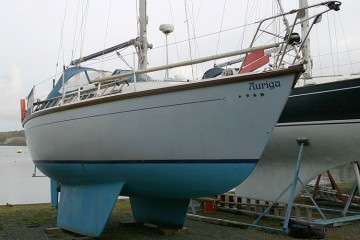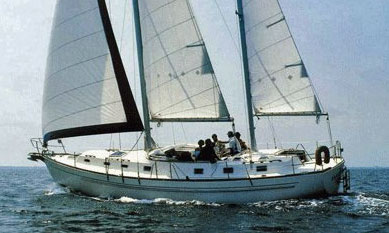
Types of Boats
Boat types are determined by three different things.
- Hull Type
- Keel Type
- Masts and Sails
Hull Types
The hull the main body of a sailboat. It meets the surface of the water at the waterline. Structure varies based on the type of boat. There are three main types of hulls. The monohull is a boat with one hull, catamaran with two, and trimaran with three.



Keel Types
Keels are the lateral part at the bottom of boats that allow a boat to move forward and not side to side when the wind hits the sail. It converts the sideways motion into a forward motion. It also keeps the boat steady and makes it heavier. There are six main types types of keels. They include full-length keels, fin keels, daggerboards, centerboards, wing keels, or bilge keels.
Centerboards and Daggerboards
A centerboard is a type of keel which can pivot out of an opening in the center of the hull. It allows the boat to efficently change direction, travel in a direction other than downwind, and remain stable. A daggerboard is a smaller version of a centerboard that takes up little space and are cheap and easy to make. They are most often used on small dinghys. Centerboards are easier to use, especially in shallow water. Boats with daggerboards can be very fast because other types of keels have more hydrodynamic drag. It is easy to raise the centerboard to avoid scraping rocks in shallow water. Centerboards and daggerboards both provide stability against high winds.

Full-length Keels and Fin Keels
Full-length keels are keels that are at least half the length of the hull. They have good directional stability and is stable against turbulence and rough water. They are move likely to fall off than smaller keels like daggerboards. It is also easier to transport boats across land when they have this type of keel, since it will stay balanced and not tip on the bow or stern. A fin keel is the opposite of a full-length keel; it is a keel whose length is less than half the length of the hull. Its name refers to its shark fin like shape. Boats with this type of keel are often used in racing because they can cut through water efficently, have a greater draft, and are very fast.


Wing and Bilge Keels
The wing keel is a keel that is similar to the fin keel in size, but has two flats horizontal to the keel that is offset from the boat. It reduces tip vortex turbulence and has less draft. Since the two flats are offset, they do not cause turbulence. One con of the types of keels is that they are very hard to remove from the sea floor if they get stuck because of the two "wings." Bilge keels are also called twin keels. They are two keels that stick out from the hull near the bilge. They are positioned at an angle to where they have a shallow draft and allow for a small amount of leeway. They are safer in shallower water.


Masts and Sails
A mast is the tall post or structure in a sailboat the holds the sails up. Sails allow the boat to sail and are normally made from waterproof fibers that let the boat catch wind. The main types of mast and sail combinations are sloops, cutters, ketches, cats, schooners, and yawls.
Sloops
When you picture a sailboat, the one you think of is most likely a sloop. They are the most common types of sailboats, with one mast and two sails. They have a mainsail and a headsail/foresail. The mast is about one third forward and about two thirds of the vessel aft. Headsails are connected by the forestay and the mast. Some different types of headsails are spinnakers, jobs, and genoas. Sloops are also called Bermuda rigs or Marconi rigs.

Cutters
Cutters are small to medium sized boats that are designed for speed. They have one mast, but can have multiple headsails. They often have two jibs and the one towards the front is usually the higher up one. It can be harder to tack (turn) with this type of boat. There are two varients of cutters, bowsprit and no bowsprit. The difference is if the foremost sail is set on the bowsprit or set close to the bow of the boat.

Ketch
Ketch rigged boats have two masts. The main one is similar to a sloop rig, and the smaller one is referred to as the mizzenmast. The mizzenmast helps control the boat against strong winds, and can be used to mount wind generators and antennas. They are great for cruising. The different sails and masts make sailing on a ketch rigged boat possible in all types of winds and weather.

Cats
Cat rigs are simple boats that only consist of one mast. That mast is normally towards the front of the boat. Cats do not do well travelling upwind. However, they are easy and manueverable when tacking, and great for sailing downwind. One common type of cat is a Laser. I sailed on Lasers and realized how easy it was to tip over because of the small size.

Schooners
Schooners are sailboats with at least two masts, and the shorter on is in the front of the boat. Many old sailboats in history were schooners. Their speed and upwind progress were good for the time period they were in. They are not efficient in set up and crewing on the ship is a lot of work. The large sails were not good at catching wind. Today, they are not as widely used.

Yawls
Yawls are similar to ketches. They have two masts (main and mizzen). Yawl rigs are not that widely used and are not very practical. They are good for looking pretty and classic.
